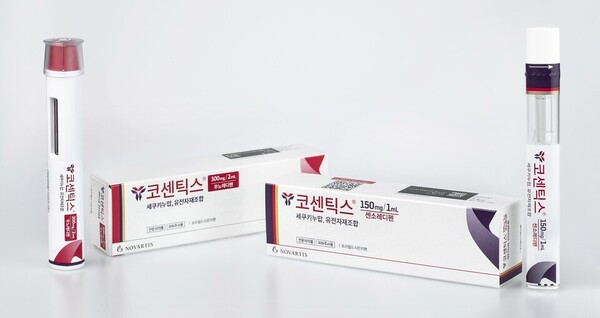The European Hidradenitis Suppurativa Foundation (EHSF) has registered Novartis' interleukin inhibitor Cosentyx (secukinumab) as a recommended first-line biologic treatment in its guidelines revised for the first time in about eight years.
According to Novartis Korea Monday, the recently updated EHSF guidelines added Cosentyx as a first-line biologic treatment for patients with moderate-to-severe hidradenitis suppurativa and inadequate response to conventional systemic therapy.

The update was first presented at the 2024 European Academy of Dermatology and Venereology (EADV) Annual Congress in Amsterdam, the Netherlands, from Sept. 25 to 28, and was published in full in the Journal of the European Academy of Dermatology and Venereology (JEADV) in December.
The new treatment options include Cosentyx, which the European Committee approved in May 2023 for treating hidradenitis suppurativa, about eight years after the 2015 update.
Cosentyx was effective in two large phase 3 programs (SUNSHINE and SUNRISE studies) in 1,084 patients with moderate-to-severe hidradenitis suppurativa.
In patients treated with Cosentyx every two weeks, the rate of HiSCR (defined as a reduction in inflammatory lesions of at least 50 percent from baseline and no increase in abscesses or draining fistulas), a measure of clinical response to the biologic, was 42 percent to 45 percent, compared to 31-34 percent in the placebo group. In patients treated with Cosentyx every four weeks, the rate of HiSCR was 46 percent, compared to 31 percent in the placebo group.
In addition, HiSCR achievement in the Cosentyx arm continued to improve through week 52 of treatment, indicating that continued treatment with Cosentyx is associated with even greater symptom improvement.
In addition, Cosentyx was shown to impact patients' quality of life positively. For example, pain is one of the most burdensome symptoms for patients with hidradenitis suppurativa, with more than 80 percent of patients with hidradenitis suppurativa reportedly experiencing periodic flares once a month.
This can negatively impact the course of the disease and patients' quality of life, which was also significantly reduced in the Cosentyx group compared to the placebo group.
In the SUNNY study, in week 16 of treatment, the achievement rate of NRS (numerical rating scale)30, a skin disease pain score, was 39 percent in the second week and 36 percent in the fourth week in the Cosentyx treatment arms, compared to 27 percent in the placebo arm. Additionally, by week 52, 79.6 percent of patients treated with Cosentyx every two weeks and 72.7 percent treated with Cosentyx every four weeks experienced no worsening disease.
“Patients with hidradenitis suppurativa are often accompanied by various complications, making it not just a skin disease but a significant impairment in their quality of life,” said Dr. Lee Weon-ju, a professor of dermatology at Kyungpook National University Hospital and president of the Korean Acne and Rosacea Society (KARS). “This recommendation is very encouraging news for patients with moderate-to-severe hidradenitis suppurativa, who have had very limited treatment options, as it allows the use of biologics as a first-line treatment and expands the options available to them.”
Professor Lee continued, “We hope this will be quickly reflected in national guidelines and insurance reimbursement so that patients will have greater access to effective treatment options.”
Related articles
- Celltrion receives go-ahead for P3 study for Cosentyx biosimilar in US
- For years, a K-pop singer’s pain went unnamed. At a Novartis screening, he shared why.
- Korea green-lights Novartis’ Cosentyx for kids with severe psoriasis
- Novartis spotlights early Cosentyx use for ankylosing spondylitis at KCR 2025
- Hidradenitis suppurativa: New drugs have emerged, but patients face a reimbursement barrier

